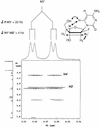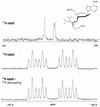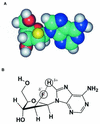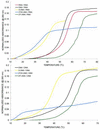2'-Deoxy-2'-fluoro-beta-D-arabinonucleosides and oligonucleotides (2'F-ANA): synthesis and physicochemical studies
- PMID: 10982885
- PMCID: PMC110742
- DOI: 10.1093/nar/28.18.3625
2'-Deoxy-2'-fluoro-beta-D-arabinonucleosides and oligonucleotides (2'F-ANA): synthesis and physicochemical studies
Abstract
Recently, hybrids of RNA and D-arabinonucleic acids (ANA) as well as the 2'-deoxy-2'-fluoro-D-arabinonucleic acid analog (2'F-ANA) were shown to be substrates of RNase H. This enzyme is believed to be involved in the primary mechanism by which antisense oligonucleotides cause a reduction in target RNA levels in vivo. To gain a better understanding of the properties of arabinose based oligonucleotides, we have prepared a series of 2'F-ANA sequences of homopolymeric (A and T) and mixed base composition (A, T, G and C). UV thermal melting and circular dichroic (CD) studies were used to ascertain the thermodynamic stability and helical conformation of 2'F-ANA/RNA and 2'F-ANA/DNA hybrids. It is shown that 2'F-ANA has enhanced RNA affinity relative to that of DNA and phosphorothioate DNA. The 2'-fluoroarabino modification showed favorable pairing to single-stranded DNA also. This is in sharp contrast to ANA, which forms weak ANA/DNA hybrids at best. According to the measured thermodynamic parameters for duplex formation, the increased stability of hybrids formed by 2'F-ANA (e.g., 2'F-ANA/RNA) appears to originate from conformational pre-organization of the fluorinated sugars and a favorable enthalpy of hybridization. In addition, NMR spectroscopy revealed a five-bond coupling between the 2'F and the base protons (H6/H8) of 2'-deoxy-2'-fluoro-beta-D-arabinonucleosides. This observation is suggestive of a through-space interaction between 2'F and H6/H8 atoms. CD experiments indicate that 2'F-ANA/RNA hybrids adopt an 'A-like' structure and show more resemblance to DNA/RNA hybrids than to the pure RNA/RNA duplex. This feature is believed to be an important factor in the mechanism that allows RNase H to discriminate between 2'F-ANA/RNA (or DNA/RNA) and RNA/RNA duplexes.
Figures







Similar articles
-
2'β-Fluoro-Tricyclo Nucleic Acids (2'F-tc-ANA): Thermal Duplex Stability, Structural Studies, and RNase H Activation.Chemistry. 2017 Aug 1;23(43):10310-10318. doi: 10.1002/chem.201701476. Epub 2017 Jun 13. Chemistry. 2017. PMID: 28477335
-
Duplex recognition by oligonucleotides containing 2'-deoxy-2'-fluoro-D-arabinose and 2'-deoxy-2'-fluoro-D-ribose. Intermolecular 2'-OH-phosphate contacts versus sugar puckering in the stabilization of triple-helical complexes.Bioconjug Chem. 1999 Mar-Apr;10(2):299-305. doi: 10.1021/bc9801171. Bioconjug Chem. 1999. PMID: 10077480
-
Solution structure of an arabinonucleic acid (ANA)/RNA duplex in a chimeric hairpin: comparison with 2'-fluoro-ANA/RNA and DNA/RNA hybrids.Nucleic Acids Res. 2001 Nov 1;29(21):4284-93. doi: 10.1093/nar/29.21.4284. Nucleic Acids Res. 2001. PMID: 11691916 Free PMC article.
-
The solution structure of double helical arabino nucleic acids (ANA and 2'F-ANA): effect of arabinoses in duplex-hairpin interconversion.Nucleic Acids Res. 2012 Oct;40(18):9329-39. doi: 10.1093/nar/gks672. Epub 2012 Jul 14. Nucleic Acids Res. 2012. PMID: 22798499 Free PMC article.
-
2'-Fluoro-arabinonucleic Acid (FANA): A Versatile Tool for Probing Biomolecular Interactions.Acc Chem Res. 2021 May 4;54(9):2287-2297. doi: 10.1021/acs.accounts.1c00125. Epub 2021 Apr 16. Acc Chem Res. 2021. PMID: 33861067 Review.
Cited by
-
Modified Nucleotides for Chemical and Enzymatic Synthesis of Therapeutic RNA.Curr Med Chem. 2023;30(11):1320-1347. doi: 10.2174/0929867330666221014111403. Curr Med Chem. 2023. PMID: 36239720
-
Aptamers Chemistry: Chemical Modifications and Conjugation Strategies.Molecules. 2019 Dec 18;25(1):3. doi: 10.3390/molecules25010003. Molecules. 2019. PMID: 31861277 Free PMC article. Review.
-
Selection of 2'-Deoxy-2'-Fluoroarabino Nucleic Acid (FANA) Aptamers That Bind HIV-1 Integrase with Picomolar Affinity.ACS Chem Biol. 2019 Oct 18;14(10):2166-2175. doi: 10.1021/acschembio.9b00237. Epub 2019 Oct 7. ACS Chem Biol. 2019. PMID: 31560515 Free PMC article.
-
Synthesis of 2-fluoro-substituted and 2,6-modified purine 2',3'-dideoxy-2',3'-difluoro-d-arabinofuranosyl nucleosides from d-xylose.Tetrahedron. 2019 Mar 29;75(13):2037-2046. doi: 10.1016/j.tet.2019.02.027. Epub 2019 Feb 16. Tetrahedron. 2019. PMID: 34316083 Free PMC article.
-
Antisense 2'-Deoxy, 2'-Fluroarabino Nucleic Acids (2'F-ANAs) Oligonucleotides: In Vitro Gymnotic Silencers of Gene Expression Whose Potency Is Enhanced by Fatty Acids.Mol Ther Nucleic Acids. 2012 Sep 18;1(10):e43. doi: 10.1038/mtna.2012.35. Mol Ther Nucleic Acids. 2012. PMID: 23344235 Free PMC article.
References
-
- Uhlmann E. and Peyman,A. (1990) Chem. Rev., 90, 543–584.
-
- Sanghvi Y. (1989) In Barton,D.H.R., Nakanishi,K. and Meth-Coth,O. (eds), Comprehensive Natural Product Chemistry. Elsevier Science, Oxford, UK, pp. 285–311.
-
- Baker B.F. and Monia,B.P. (1999) Biochem. Biophys. Acta, 1489, 3–18. - PubMed
Publication types
MeSH terms
Substances
LinkOut - more resources
Full Text Sources
Other Literature Sources

